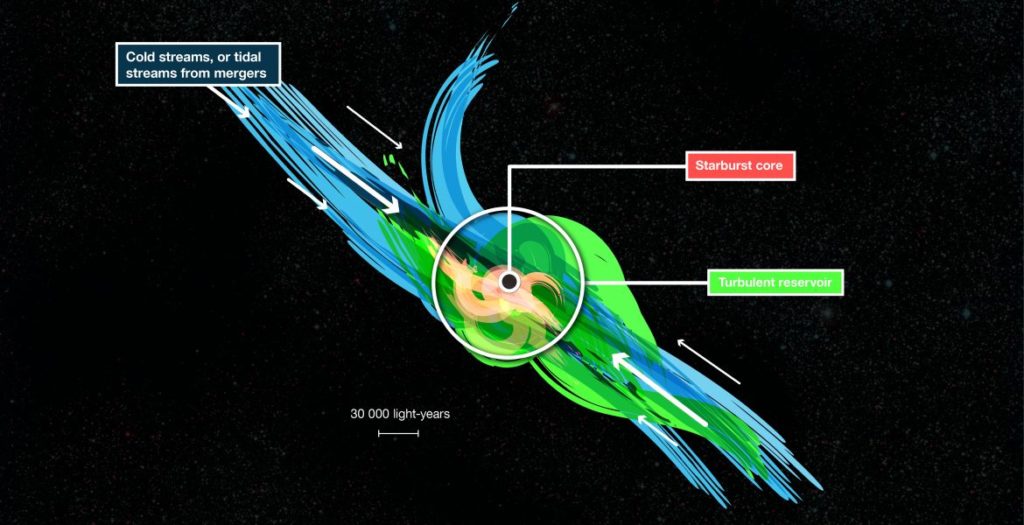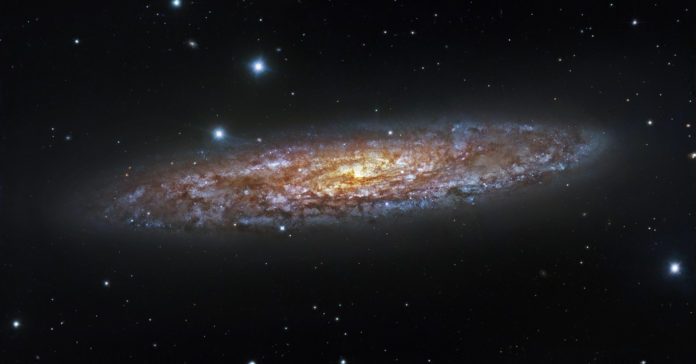A very long time ago, in the early days of the universe, starburst galaxies converted large amounts of hydrogen gas into new stars at an alarmingly fast rate. Because of the intenseness of this formation, many of the younger galaxies found themselves being devoid of hydrogen which meant their star formation rate decreased significantly. For some reason, a select number of young galaxies retained their star-forming power once similar galaxies had become settled.

In a new study, researchers used the Atacama Large Millimeter/submillimeter Array (ALMA) in which to observe these distant starburst galaxies. What they discovered was out of the six distant starburst they observed, five were surrounded by violent reservoirs of hydrogen. The researchers discovered these regions through the high concentration of carbon hydride (CH+) molecules floating around. New observations taken by ALMA have helped explain how galaxies have the ability to extend their star formation period.
“By detecting these molecules with ALMA, we discovered that there are huge reservoirs of turbulent gas surrounding distant starburst galaxies. These observations provide new insights into the growth of galaxies and how a galaxy’s environs fuel star formation,” commented Edwin Bergin, an astronomer at the University of Michigan, Ann Arbor, and co-author on the paper. What the researchers observed in the CH+ were dense shock waves that were being powered by the hot galactic winds building up from inside the galaxy’s star forming regions. The violent nature of the winds is capable of recapturing part of the material that’s originally pulled out. The material then settles into cool, gas reservoirs, extending from the galaxy’s star forming region by further 30,000+ light-years.
Edith Falgarone, the leader of the new ALMA observations, confirmed, “With CH+, we learn that energy is stored within vast galaxy-sized winds and ends up as turbulent motions in previously unseen reservoirs of cold gas surrounding the galaxy. Our results challenge the theory of galaxy evolution. By driving turbulence in the reservoirs, these galactic winds extend the starburst phase instead of quenching it.” Concluding that on their own the galactic winds couldn’t replenish the newly formed gas reservoirs, the researchers suggested that the mass comes from galactic mergers or accretion instead from hidden but steady streams of gas.
ESO’s Director for Science and co-author of the paper Rob Ivison commented on the breakthrough: “This discovery represents a major step forward in our understanding of how the inflow of material is regulated around the most intense starburst galaxies in the early universe. Of shows what can be achieved when scientists from a variety of disciplines come together to exploit the capabilities of one of the world’s most powerful telescopes.”
More News to Read
- Do Physicists Need to Change the Way They Measure Quantum States?
- Researchers Discover Response in Liver Could Actually Help Treat Alcoholism
- Ancient Nova Explosion Recovered by 580-year-old Korean Recording
- Scientists Use VLA to Measure Galaxy’s Magnetic Field Billions of Light-Years Away
- Who Said Oil and Water Don’t Mix? New Study Suggests Otherwise

